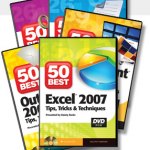I have uploaded many of my PowerPoint Training Videos to YouTube. Here is the link to my YouTube Channel:
http://www.youtube.com/user/DannyRocksPowerPoint
YouTube reaches a very broad audience. It offers a very different experience. YouTube makes it very easy to share the videos that you like with your friends and colleagues. Check it out for yourself!
I must admit that I was wary about uploading my training videos to YouTube. However, I have had a very positive response to my MS Excel Videos on YouTube. So I have created a separate PowerPoint Channel and have begun to upload content from this website to YouTube.
If you want to share any of my Excel or PowerPoint Videos, YouTube make it easy to do so. You can even choose to embed the videos on your own website – go right ahead! I have included my business card at the beginning and the end of each video so that viewers know how to reach me.
Let me know what you think about YouTube. How is it different from this blog? Have you ever shared a video that you found on YouTube with your friends. Have you ever embedded a YouTube video on your own website?
I invite you to add your comments below.



